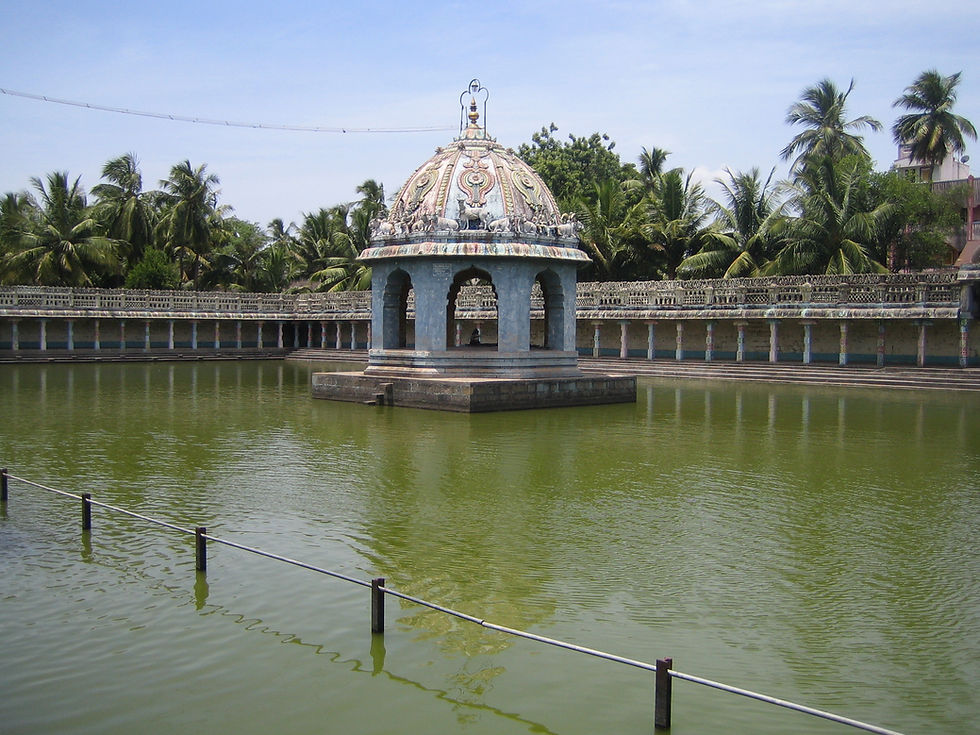Temples of Tamil Nadu and Pondicherry #60: Veerattaneswarar Temple, Thiruvathigai
- Sudharshan
- Jun 7, 2024
- 3 min read
Updated: Jul 25, 2025
வீரட்டானேசுவரர் திருக்கோயில், திருவதிகை
About an hour southwest of Pondicherry lies this very important temple for Tamil Saivites.
The Saivite saint Thirunavukkarasar or Appar was born close to here at a village called Thiruvamoor (திருவாமூர்), in a staunchly Saivite family. He was named Marulneekiyar(மருள்நீக்கியார்) at birth. He had an older sister named Thilagavathy (திலகவதி). Thilagavathy was married to a young soldier in the Chola army which was fighting in alliance with the Pallavas at the northern borders. When Marulneekiyar was a young boy, both his parents died and his brother-in-law was killed in battle at the front. The two young people became orphans. Disillusioned by all this tragedy, Marulneekiyar joined the Jain Monastery at Patalipuram or present day Cuddalore (கடலூர்) and became a Jaina monk and assumed the name Dharmasenar. Thilagavathy, meanwhile devoted her time serving Lord Siva at this temple Thiruvathigai. She prayed everyday that her only sibling should return to the Saivite fold. One day the monk Dharmasenar was afflicted with an unrelenting abdominal pain. The Jain monks tried all the remedies they knew of and could not cure him. Incurable stomach illnesses were commonly called Soolai (சூலை நோய்) at that time. Finally the Jains brought Dharmasenar to his sister and told her that he was going to die. Thilagavathy in desperation took her brother to the sanctum of Lord Siva here at Thiruvathigai and as soon as he worshipped here the abdominal pain disappeared. Grateful and relieved he sang his first Thevaram and the first Thevaram of the Thirumurai, Kootrayinavaru Vilakkahileer….He sang so beautifully that he got the name Thirunavukkarasar- the Lord of the tongue.
கூற்றாயின வாறு விலக்ககிலீர் கொடுமைபல செய்தன நான்அறியேன்
ஏற்றாய்அடிக் கேஇர வும்பகலும் பிரியாது வணங்குவன் எப்பொழுதும்
தோற்றாதென் வயிற்றின் அகம்படியே குடரோடு துடக்கி முடக்கியிட
ஆற்றேன்அடி யேன்அதி கைக்கெடில வீரட்டா னத்துறை அம்மானே.
Please pay attention to the last line - "athigai kedila". The Kedilam is a river and runs close by even today. Historically this event is dated to around 600 to 620 CE. This temple is a Paadal Petra Sthalam and one of the 8 Ashtaveerattanasthalams. The Lord in these 8 temples scattered around the Tamil country is called Veerattaneswarar or Veeratteeswarar and they commemorate a valiant exploit by the lord. Here at Thiruvathigai the Thiripura Samharam is commemorated.
The structure we see today, likely did not exist at the time of Thirunavukkarasar. The sanctum and the Vimanam were apparently built by the Pallavas. Parameswaravarman I (670 - 695 CE) is the king who started the structure which would make it one of the earliest structural temples on par with the Kailasanathar at Kanchipuram and the Shore Temple, Mahabalipuram. The Vimanam looks like the one at Kailasanathar and people claim that this was a prototype and inspiration for the Periyakoyil at Thanjavur. All 3 vimanams are designed in such a way that the shadow of these pyramidal structures never falls on the ground. The unique feature of this temple is the stucco (சுதை) images that are on the vimanam and the walls of the sanctum. It is doubtful that they are as old as the temple itself as stucco does not last and has to be redone from time to time. They look Nayakkan in style and if so they have been beautifully and skillfully incorporated into the main structure. It is a stunning temple, one of the most beautiful temples we have been to and we have been to many. At 7 acres and with multiple prakarams it is a fairly large temple There is a statue of Lord Buddha in the outer prakaram which is quite ancient and is worshipped to this day and is a testament to the Buddhist heritage of this region.
It is located about 45 km or an hour southwest of Pondicherry in the town of Panruti. We visited in May 2023. We were based in Pondicherry.

Credits: Google Maps



























Comments